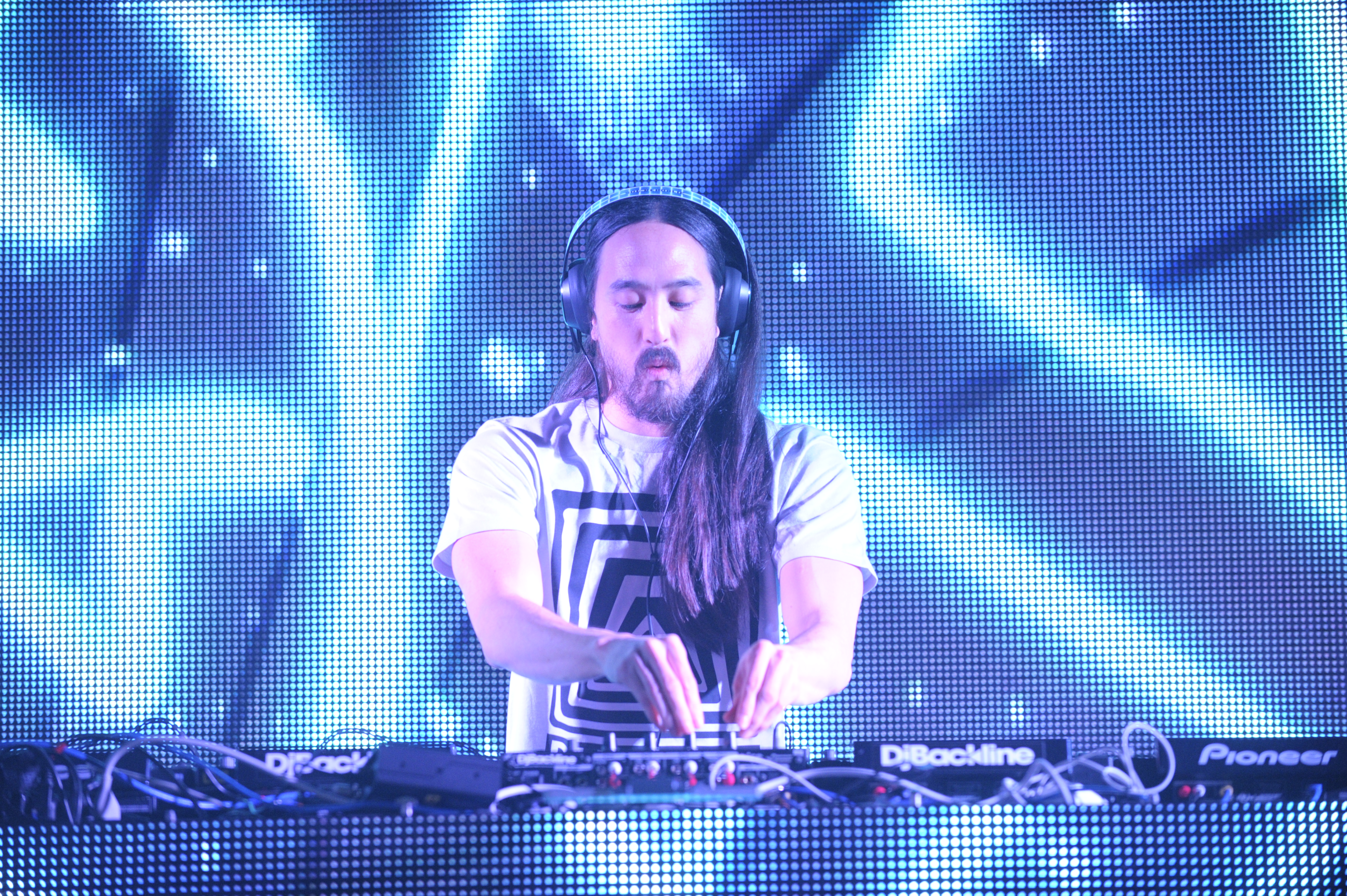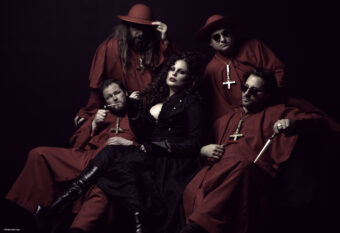In the festival world, Steve Aoki is not just a DJ; he’s a myth. He has defined his high-energy live-shows via a series of signature, persona-defining antics—Aoki doing a high jump off the decks; Aoki crowd-surfing on pool floatie; Aoki hurling sheet cakes into eager faces in the crowd. One of the 39-year-old DJ/producer’s most heralded characteristics is that he never seems to tire, a point which was underscored by the title and substance of I’ll Sleep When I’m Dead, the 2016 Netflix documentary about his career, family, and psyche. On a Wednesday morning in mid-July, he arrives for brunch at an Italian restaurant in Manhattan looking pert and lithe, his silken black hair cascading down a t-shirt from his Dim Mak label. “I’m so tired right now,” he says, still perky. “But I mean, when I get tired I also have to remind myself what I’m doing, and then I get excited. And I’m like, ‘It’s okay to be tired, [it’s the] body’s response.’”
What I’m doing, in Aoki parlance, is basically everything, all at once. Just this week, he confirmed a forthcoming collaboration with K-pop stars BTS, the seven-member boy band which is gunning to be as globally huge as possible. In the near-decade that he has been a successful producer and DJ—one of the world’s highest paid since 2012—he has also built a record label, a fully self-funded fashion line, and a charitable foundation, all seemingly propelled by his enthusiasm for spectacle. The night before we meet, he shut down a full city block near New York University and staged a thousand-person listening party for his fourth full-length album, Steve Aoki Presents Kolony. It’s a diesel-fueled, trap-minded selection of collaborations with rappers and fellow producers—a document of the two years in which Aoki revamped his music-making process to, as he puts it, “give the landscape for these artists to be 100 percent themselves.” During the show, Aoki brought out a phalanx of rappers, including Ma$e, the timeworn New York royal who features on Kolony, as well as Ayo and Teo, the hit young “Rolex” luminaries for whom he contributed a juiced-up party remix. He pumped up the crowd from behind the decks, his visuals occasionally reminding fans they were watching STEVE AOKI, lest they forget. The set culminated, as his performances always do, in the facial smash of three yellow cakes, the word “KOLONY” scrawled on them in inky icing.
The block party also served as a runway show for Dim Mak’s Spring 2018 line. Though the party went down at the tail end of Men’s Fashion Week, Aoki wasn’t necessarily trying to lure a fashion crowd to see the looks, a collection of edgy streetwear in army green and oversized parkas displayed under the theme “Paradise Found.” “I’m here to showcase my fashion to my culture, and to the community that supports me,” he said later. “[There was] a lot of strategy and planning and thinking about combining the worlds, a lot more than I have ever done before. Before, I was like, ‘Alright, here’s the fashion world and here’s the music world, and we’re gonna separate them.’ And now we’re like, finally fusing the cultures together more.” As tour merch becomes an accepted vernacular on high fashion runways—see, for instance, Shayne Oliver riffing on the Helmet logo for Helmut Lang t-shirts—Dim Mak clothing is imagining its music fans as hypebeasts, starting out with the logic of scarcity. “It’s like you’ve entered into this very exclusive club, ’cause there’s not many people that are going to be able to have these clothes,” he says. “Hopefully we’ll expand that, but that’s how it’s gonna start.”
Aoki’s sense of showmanship was irrepressible on the runway—it opened with a drumline of 12 men marching in full Dim Mak regalia. Likewise, his political instincts were on display, via the kind of sloganeering that passes for politics in fashion these days; hoodies were emblazoned with “LAND OF THE FREE, HOME OF THE BRAVE,” and paint-splattered denim was inspired, Aoki says, by the paint in the interior of One World Trade Center, which he first observed during Kolony‘s press run. “I wanna reclaim those words, ‘land of the free, home of the brave,'” he says, “because it only really represents a few people, because it doesn’t represent all immigrants that come to and make up the United States. So it’s reclaiming that, finding that, guiding towards that, it’s our own response, through our own fashion, our own way to say that.”
More explicitly, Aoki sees his line as a retort to the notion that the way to “make America great” is by fear and exclusion. “[The line] was really based on the pink elephant in the room that we’re dealing with,” he says. “We live in a state of chaos, we live under Donald Trump. Like, first of all, [it’s] confusing, and then chaos, and violence and terror and, you know, just all this shit, like regression… that’s the state we’re in. But, I always wanna look at it in a very holistic approach, and find the way out—to try and find the paradise, the happiness. It’s like finding hope in the hostile environment that we’re living in.”
Aoki’s politics are not new. He founded the record label Dim Mak 21 years ago, in 1996; before he helped launch the careers of The Chainsmokers and The Bloody Beetroots, Dim Mak was primarily a vehicle for politically minded bands from the SoCal punk and screamo scene in which Aoki cut his teeth. (I first met Aoki in the early 2000s, in a grungy burlesque bar in Portland, where he was holding a party for one of the early Dim Mak releases I was writing about—a live album by a then-local band called The Gossip.) In the years since, he has translated the values he learned in the underground punk scene—community, leftist politics, DIY—to his current empire. It’s easy to make the connection between being a punk band in a van and earning 2014 Guinness World Record for “Most Traveled DJ.” (“DIY,” he says, “is the backbone, the anchor, to every creative process, every idea into execution.”) He tours almost constantly, another facet to the myth of Steve Aoki: In the week after we met up in Manhattan, Aoki hit five more countries, including Kazakhstan and Spain, where his Tomorrowland Unite headlining slot was pre-empted by a stray pyrotechnic that transformed the carnivalesque stage into a fireball. (Twenty thousand attendees were evacuated; no one was hurt.)
Casual observers of Aoki’s career might write him off because of how he made his name in the EDM world. His work ethic may be obscured beneath the energetic stage leaps and the pastry gags; even as corporate EDM has seemingly reached its most Vegas-vomiting bacchanalian apex, whenever Aoki makes new music it feels as if he’s pushing the levels ever further into the red. On 2015’s Neon Future Odyssey, for instance, he collaborated with Fall Out Boy, will.i.am, J.J. Abrams and Snoop Lion, among others, for a 28-track album that turnt up so hard it was at times vulgar. Upcoming in the Aoki portfolio is a collection of “video gaming gambling machines” based on his Neon Dreams mixtape series; if the Vegas club scene has already been conquered, then why not branch out to the casino floor?
[featuredStoryParallax id=”260025″ thumb=”https://static.spin.com/files/2017/09/GettyImages-478027752-1506541465-300×200.jpg”]
Because of his ubiquity and outsized persona, Aoki has often served as an avatar for EDM haters, a vessel for everything outsiders deem unholy about overdriven drops and festie culture. His Netflix documentary, produced by the team behind Jiro Dreams of Sushi, seemed like a corrective to that notion, exposing the more complex man beneath the flashy surface exterior. The film suggests there is a connection between Aoki’s dogged motivation and his theatricality and the similar traits in his late father, the flamboyant ex-wrestler and Benihana proprietor Rocky Aoki, who brought a performative style of Japanese food to the United States in the 1960s and pushed life to the limits. In that narrative, Rocky Aoki transcended racial barriers and defied stereotypes to become a successful businessman. His son has found his own way to do the same; on Forbes’s 2016 Electronic Cash Kings, a list of the world’s highest-paid DJs, Aoki is one of two people of color among a sea of white men, and the only listee of Asian descent. (Aoki clocked in at number five, earning $23.5 million in Forbes’s scoring period.) One way Aoki became so in-demand across the world is that he began booking shows in parts of Asia where other DJs weren’t touring, a bit of entrepreneurial genius mixed with an understanding of an underserved global fanbase.
In the restaurant, Aoki declines the doughnuts—”I’m on the Aoki workout plan,” he says—and dives into a hungry-man sized plate of grilled octopus and a green tea with mint. Though he is still ostensibly beat from the previous night’s block party, he is halfway through a 14-hour day, having arrived fresh from an appearance on Live With Kelly & Ryan, where Aoki performed his new single, “$4,000,000” with the Los Angeles production crew Bad Royale and legendary Harlem rapper Ma$e. After the performance, Kelly Ripa put her finger in Ma$e’s dimple. (“I’m going to put my finger in your dimple,” she said.)
In person, Aoki is relaxed and personable–the same livewire character he appears to be in the documentary. His love for extreme, big-gesture ideas is underscored by his ability to actually execute them. “I’ve been trying to hit up Elon Musk to do a song with me,” he says, in earnest. “[Collaborators] don’t necessarily have to be musically inclined, I just need to have their inspiration, their voice, to lend their spirit to a song.” He brings up Neon Future Odyssey’s opening track, “Transcendence,” which featured the futurist author Ray Kurzweil delivering a monologue about a utopian “neon future” over a heavenly synth track. “[Kurzweil] opened me up to a whole new world of future science, and looking at science fiction in a different way, ‘cause there’s a lot of science fiction that’s turning into science fact. And it’s really exciting that some of these imaginative ideas are really gonna happen, in possibly, hopefully, our lifetime. Like, the idea of turning into androids and living forever. Those things like that, where you’re like, ‘What?’ I mean, it’s awesome, awesome.”
Did you see the thing Elon Musk said, I ask, that was like, “We need to reign in artificial intelligence before it overtakes us?
“He’s been saying that for a while. My opinion of that is that of course we need to reign it in. We’re always gonna find safeguards. As we develop new technologies, I think that’s just like in our own survival instinct. I think we always live for our own safeguard. But I think in the end, what will happen is, the AI will become part of us, and we will be robots.”
That’s sort of presenting the idea of immortality.
“A hundred percent! Indefinite life. Unless you get run over by like, some spacecraft.”
‘Living forever’—an apt life philosophy for someone who’s incorporated multiple identities into one bigger-than-life party person. He grew up the son of a daredevil Japanese restaurant magnate, cut his teeth in the screamo scene and furthered his musical education with DJ AM and Hollywood socialites; he’s a punk from a legacy family, a dance music superstar with underground grit, a millionaire whose punk and DIY ethos drives every project he envisions. It’s through his ability to shapeshift, perhaps, that Aoki has learned to tune everyone else out and trust himself. “I feel like I have a lot of different worlds in me that have inspired me, so I’m either genre-full, or genre-less,” he explains. “I’m all genres. So that allows me to feel like I can go in any direction I want. I’m not trying to be a traditionalist, you know? I’m not trying to stay within the lines. I’m not listening to critics; that’s the most important thing I’ve learned, is I don’t care. If you don’t like it, it’s okay. It doesn’t bother me if the world doesn’t like it. If like, the Rotten Tomatoes of music doesn’t like it, I don’t care. It’s already happened, I’ve already been hated by like, the world’s most famous critics. I just stopped caring. I have to continue doing what I do, and I have to believe in it.”
In the past two years, while making Kolony, Aoki has perhaps relaxed musically. His latest album has more focus than Neon Future Odyssey, and “Just Hold On,” his current hit with former Directioner Louis Tomlinson, seeks balance between a pop vocal and a dance party hook. Kolony features some of the biggest rappers of 2017, including Gucci Mane, Lil Uzi Vert, Lil Yachty, Migos, and Wale, among others. It is not a referendum on a shifting genre—Aoki was one of the first producers working in festival-circuit EDM to collaborate with hip-hop artists, recording memorable collaborations with Kid Cudi, Lil Jon, and Waka Flocka Flame—but it does sound like an acknowledgement that Aoki’s genre is becoming something else. “The EDM process is rescripted, where it’s not necessarily the music leading the song, it’s the vocalist leading,” he says. “It’s not about the drops or the sound design, it’s more about the vocals, and the singer being the drop, being the sound design. They are the moment that makes the song important…. You can’t marry yourself to a traditional set of rules that you’ve worked with. You have to start from scratch again.”
Kolony’s lead single, “Kolony Anthem,” features ILoveMakonnen and Bok Nero declaring, “We just turned a gang into a colony” over a hefty, festie-ready trap break. It’s as salient a mission statement for Aoki as any. The song declares his intention to build up a community and remain flexible enough to go where his fans go. “Music is one thing and the trends are gonna come and go, but you’ve seen the waves… you’ve seen a trend that’s so big and popping, and you think it’s undefeatable, and then it’s gone,” he says. “The things that don’t really die, is the energy that kind of runs through all genres or trends. It’s like, the energy attracts to a trend, right? The energy attracts you to a culture, to an experience. I focus on the energy and not the trend. That way, when a trend goes away, I don’t go with the trend, either. I follow the energy.”





